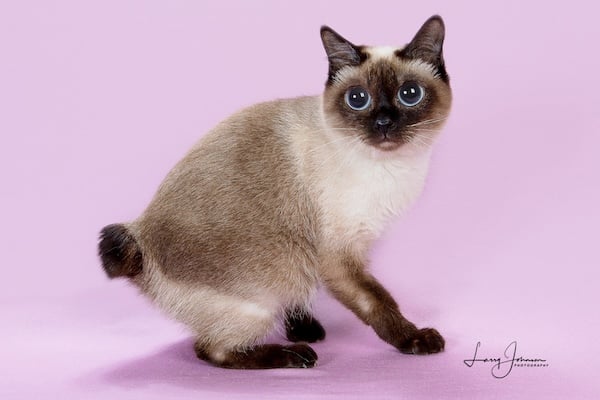- Not a substitute for professional veterinary help.
If you’re in your itty bitty kitty era, you might be considering welcoming a feline friend from one of the smallest cat breeds into your life. Because let’s be real. When it comes to tiny animals, why should pocket-sized pooches like Chihuahuas get all the love?
With small cat breeds, it’s hard not to become immediately smitten with these cuddly, kitten-sized cuties. But there’s much more to small cat breeds than their size and appearance.
While some of these cats are perfectly petite thanks to nature alone, like the Toybob, there’s a dark side to what are known as “dwarf” and “teacup cats,” who are often the victims of unregulated and unethical experimental breeding.
We spoke to Desiree Bobby, Brand and Marketing Director of The Cat Fanciers’ Association and founder of the USDA-Licensed and BBB-Accredited Beeblebrox Sphynx Cattery, as well as Dr. Wendy Hauser, DVM, Founder of Peak Veterinary Consulting and Special Advisor to ASPCA® Pet Health Insurance. With their help, we explain what to know about small cats, plus some of the concerns about pursuing these tiny cats for their cuteness factor alone.
What Are the Smallest Domestic Cat Breeds?
The smallest domestic cat breeds officially recognized by feline associations, says Bobby, are the Singapura and Toybob. Here’s what the CFA has to say about these tiny kitties.
Singapura
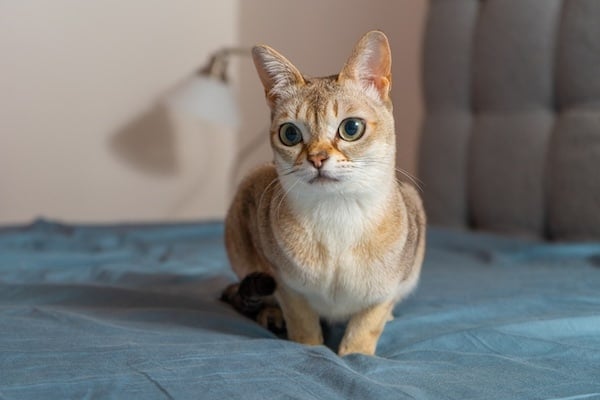
The Singapura cat is a naturally occurring mini kitty. Viktor via iStock
These diminutive cats got their start as Singaporean street cats. They’re easily recognizable for not only their small stature but also their elegant Siamese-like coloring and Cheetah-like facial markings. Don’t be fooled by their size—Singapura cats are muscly climbers and active, interested playmates. They’re both vocal and energetic, making them a good fit for active cat-loving families.
- Size: 4 to 7 pounds
- Distinctive features: Big and round expressive eyes, a very round head, and a sparkly coat due to their sepia agouti fur (multiple bands of color on each hair shaft)
- Personality: Extroverted, intelligent, people-oriented, vocal, and energetic
- Activity level: High energy, very playful, and intelligent—requires frequent play sessions and enrichment
- Health risks: May develop progressive retinal atrophy (PRA) which can lead to blindness and Pyruvate Kinase Deficiency (PKD)
- Lifespan: 9 to 15 years
Toybob
If you’re looking for a cat who retains a kitten-like size and appearance, the Toybob fits the feline bill! Native to Russia, the Toybob is one of the smallest cat breeds in the world. When fully grown, Toybobs have bodies and proportions comparable in size to a six-month-old kitten. Their bobbed tails and diminutive size are the result of natural mutations, not human influence or manipulation—and neither affects their mobility or causes pain or health problems.
- Size: 3 to 7 pounds
- Distinctive features: Large round eyes, plush fur texture, unique vocalizations like trills and chirps, and compact muscular body with broad ribcage (not a refined or delicate build)
- Personality: Affectionate, sociable, docile, curious, and good with other cats
- Activity level: Varies from snuggly lap cat to energetic and playful
- Health risks: Dental problems like periodontal disease are common
- Lifespan: 10 to 15 years
Health Concerns for the Smallest Cat Breeds
Both the Toybob and Singapura cat breeds are smaller than the average household cat. Because of that, Dr. Hauser says they require fewer calories per day. It’s easy to accidentally overfeed these small cats, and extra pounds could lead to serious diseases and chronic illnesses like diabetes and joint disease. For that reason, it’s best for small-cat caregivers to work closely with their veterinarian to create an individualized meal plan for their small cat.
As with smaller dog breeds, which are up to five times as likely to be diagnosed with dental disease than larger breeds, Dr. Hauser says small cat breeds like the Toybob are also potentially more susceptible to problems with their teeth and gums.
Genetically, Singapura cats are at risk for the fatal genetic condition Pyruvate Kinase Deficiency, or PKD. This metabolic disease results in red blood cell destruction and abnormalities and can lead to anemia and other blood disorders.
Singapura cats may also be genetically predisposed to progressive retinal atrophy (PRA), which can lead to blindness. Cat parents-to-be who want to get a Singapura from a breeder are advised to get their new kitten from a cattery that screens for PKD and PRA.
The petite stature of Singapura and Toybob cats also means that they’re not as suited to living a free-roaming outdoor life. They’re at greater risk for injuries and attacks from wildlife like hawks, owls, coyotes, and foxes, as well as car accidents.
For cat parents who want to give their small cat outdoor exposure as a part of their environmental enrichment, it’s safest to install a secure enclosed space like a catio. You can also leash and harness train a Toybob or Singapura, especially when they’re kittens, to take them for walks.
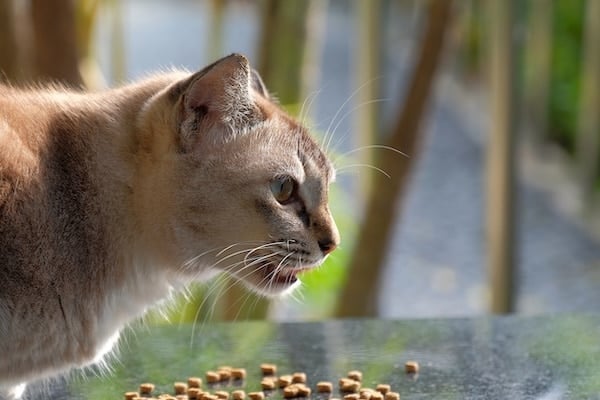
The Singapura needs a carefully monitored diet. Wirestock via iStock
The Problem with Dwarf and Teacup Cats
Now that we’ve established that there are only two recognized smallest cat breeds, it’s time to take a closer look at dwarf and teacup cats. These genetically modified small cats aren’t actual breeds, and they’re are problematic from both a health perspective and an ethical one.
Small cats, big health problems
Dwarf and teacup cats aren’t simply felines in miniature. These cats, like the Munchkin and its hybrid mashups the Minuet (formerly known as the Napoleon), the Bambino, and the Kinkalow, are the product of experimental breeders. In general, breeding processes exaggerate their features to the detriment of the cat’s health and well-being.
“All pets should be bred with the goal of producing offspring that are happy, healthy, and can live a great quality, comfortable life. Selectively breeding for physical characteristics often results in significant health problems for the pet,” Dr. Hauser says.
Dwarf and teacup cats, such as the Munchkin and Napoleon, are selectively bred and manipulated to resemble kittens even into their adulthood, regardless of the negative health impacts. While their forever-young-and-tiny aesthetic has a high cuteness factor, the harsh reality is that these cats have significant health problems.
With their dramatically stumpy legs and elongated backs, Munchkins are prone to spinal deformities and chest problems, Dr. Hauser explains. Their unnaturally small bodily proportions puts them at greater risk for a lifetime of chronic pain, joint disease, and potentially even paralysis.
Minuet (formerly Napoleon) cats are a hybrid of Munchkins and Persians. Along with inheriting Munchkins’ health problems and complications, Minuets also have the Persians’ characteristic flat face and are likely to spend their life fighting for breath due to Brachycephalic Obstructive Airway Syndrome, says Dr. Hauser.
Dr. Hauser urges small cat lovers to make a conscious decision, not an emotional one, when it comes to adopting or buying a tiny kitty.
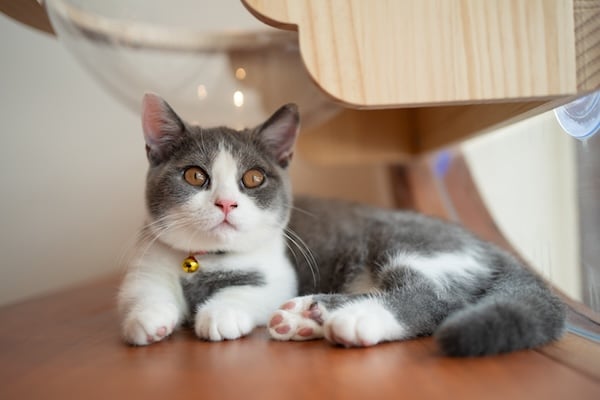
The Munchkin cat is prone to serious health issues. Irene Cheng via iStock
Small cats, big ethical problems
“Have you ever wondered how official cat breeds maintain their consistent appearance? It all comes down to something called cat standards that each official breed holds,” Bobby explains.
Breed standards for cats, small or otherwise, are detailed documents that outline the physical characteristics that define a cat breed.
“From the shape of their head to the structure of their body and the specifics of their coat, these standards serve as a blueprint for breeders to adhere to. They essentially guide breeders on what traits to aim for when breeding cats of a specific breed,” Bobby says.
Unlike officially established cat breeds, experimental or “designer” cat breeds like Munchkins and Napoleons don’t have breed standards.
“They often lack evaluation by top feline geneticists and responsible practices such as ancestry tracking and DNA testing,” Bobby says. “The lack of oversight and regulations regarding their appearance and health means unprofessional breeding practices could compromise the well-being of the cats involved.”
Like Dr. Hauser, Bobby emphasizes that it’s crucial for cat lovers to stay informed and mindful when selecting small cat breeds.
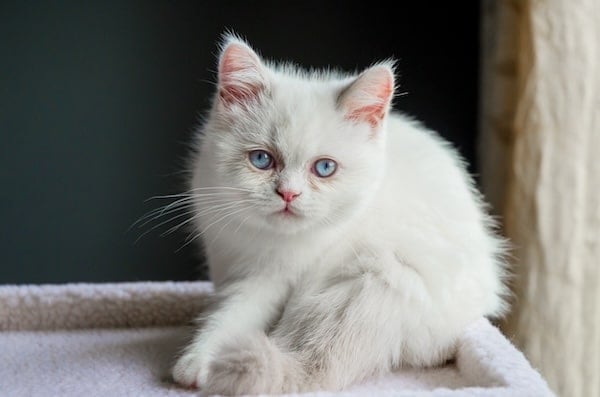
The Minuet is a hybrid of Munchkin and Persian cats. eyfoto via iStock
How To Adopt a Tiny Cat from a Reputable Breeder
“Finding a legitimate and reputable breeder can be a daunting task,” Bobby says. “Pedigree cat buyers truly need to conduct their own research to find a reputable breeder who prioritizes the well-being of their cats and kittens.”
A reputable small-cat breeder will only offer kittens at least 12 weeks or older. They’ll offer pedigree verification, do health and DNA testing, and permit home and virtual tours. You’ll also want to make sure to check reviews and social proof.
1. They meet basic requirements
Reputable breeders typically will keep their kittens until they’re at least 12 weeks old before sending them off to their new homes. Beyond that, an ethical breeder ensures their kittens are spayed or neutered, fully vetted, and tested for FIV/FLV before going to their new home.
“If a breeder is not spaying or neutering or letting kittens leave early, run!” Bobby advises.
2. They have pedigree verification
“A cattery name and number shows a breeder has a recorded name with a registry, but it doesn’t validate that they have pedigree cats,” Bobby says.
To ensure the breeder really works with pedigree cats, Bobby suggests prospective small cat parents request to see proof of registration with an esteemed and recognized feline registry like CFA. It’s also important to see documented pedigrees of the kitten’s parents to validate their lineage.
3. They do health and DNA testing
“All breeding cats should undergo DNA testing for feline diseases and traits. A reputable breeder will be able to provide results from reliable sources like mycatscan.com, which covers vital health aspects including blood type and hereditary diseases,” Bobby says.
Many cat breeds require specific health tests. Bobby encourages cat lovers who want a specific breed to research what tests are necessary for that breed. For example, since Singapura cats are at risk for the serious genetic disorders and diseases Pyruvate Kinase Deficiency (PKD) and Progressive Retinal Atrophy (PRA). They may require annual diagnostics and testing to ensure they’re healthy enough for the cattery to breed them.
4. They encourage a home visit or virtual tour
As adorable as kittens are, pictures and short video clips on social media and websites alone aren’t enough. Before choosing a small cat breed from a cattery, it’s best for prospective cat parents to request to visit the breeder’s home in person or via video call if they’re located out of state.
“This allows you to verify their authenticity, interact with the kittens, and gain insights into their breeding environment,” Bobby says.
5. They have reviews and social proof
The internet and popular social media apps are an especially powerful tool for finding honest reviews and feedback that highlight the credibility of breeders and the levels of care they give their cats and kittens. The Better Business Bureau (BBB), Google Reviews, and platforms like Yelp, Facebook, and Reddit can also give you an inside look at what those breeders are (or aren’t) doing well.
Additional indications that a breeder is ethical and professional include:
- USDA certifications
- Participation in cat shows (Bobby says this indicates a commitment to adhering to breeding standards)
- Buyer protection contracts for genetic defects
- Transparent health information

